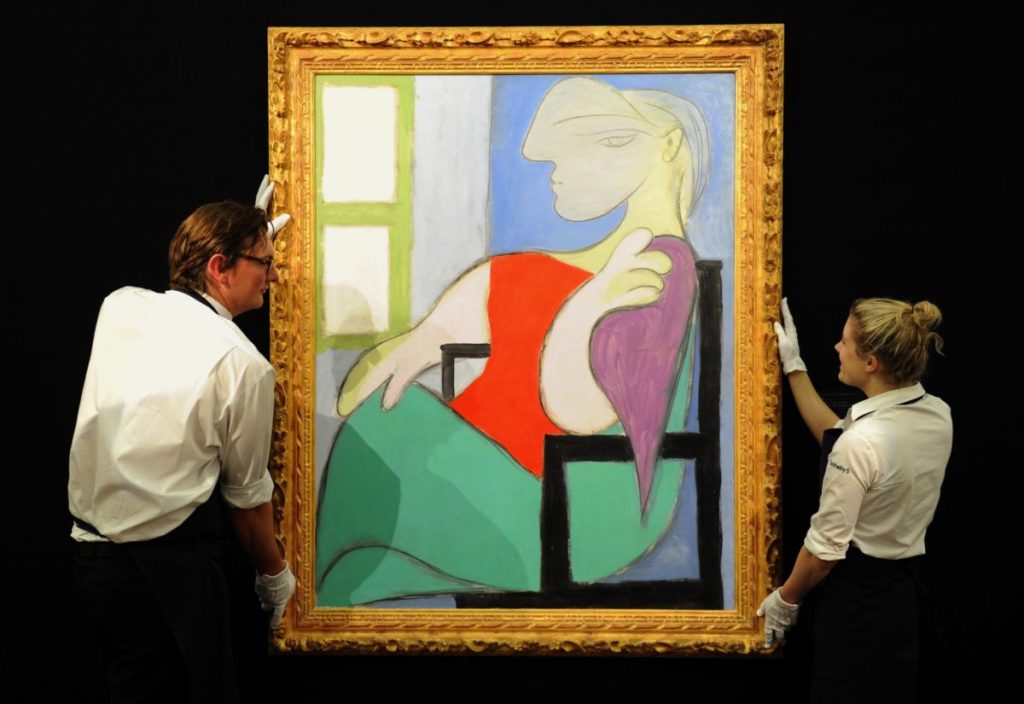 Pablo Picasso, Femme assise près d’une fenêtre (Marie-Thérèse), 1932. PA Wire/Press Association Images
Pablo Picasso, Femme assise près d’une fenêtre (Marie-Thérèse), 1932. PA Wire/Press Association Images
After a tumultuous period during the first phase of the pandemic, Christie’s, Sotheby’s, and Phillips have bounced back in 2021 to pre-pandemic sale levels.
An analysis of data across 13 modern and contemporary art sales that took place at the three houses between New York, London, and Paris from April through July show abiding strength. During that time the three houses brought in a total of $1.7 billion. This up from the $1.1 billion achieved in global evening and day sales during the same period in 2020. Pablo Picasso and Jean-Michel Basquiat led the comeback. Emerging names like Flora Yukonivich, Salman Toor, and Cinga Samson are also on the rise.
Auction house executives have pointed to several reasons for the return to normalcy in the art market. A boost in buying from clients based in Asia is one reason they cite. A balance between the supply of top works available on the market and demand is another. Basically, strong sales have encouraged owners of the most valuable property that now is the time to sell.
Unlike the uptick in Asia, market hubs in the have West plateaued year-over-year. According to a recent report published by London art market data firm Pi-eX, auctions in North America, which is typically the largest regional market, fell even further in 2021. The U.S. saw a 16-percent drop from its 2019 sales volume instead.
It’s no surprise that Picasso and Basquiat are reigning at auction; the two have long held dominant market share in Western sales. But this season has seen their appeal grow even more global. Both artists had market shares among the top Asian artists in Hong Kong sales.
In the New York, London, and Paris series, Picasso achieved the highest market share across the modern and contemporary categories with a total turnover of $187 million. Basquiat came in second with a total turnover of $168 million. Andy Warhol, whose market share has slumped in recent years, saw an uptick this season bringing in a total of $98 million.
The fourth and fifth highest sellers across the day and evening sales were Cy Twombly and Claude Monet, achieving an overall turnover of $51.7 million and $50 million respectively. Unlike Basquiat and Picasso, there are fewer works by Twombly and Monet available at public auction. This season, Twombly and Monet both had sales volume provided by only two paintings.
Of the 738 artists offered between the day and evening sales, Joan Mitchell was the only woman to reach the top 50 highest selling artists. Four works by the second generation Abstract Expressionist brought in a total of $30 million. Renewed scholarly attention and works sold from major American estates like Barney Ebsworth and Ginny Williams between 2018-20 have boosted Mitchell’s market. Since then, her market has lost some momentum at auction.
Another top selling artist was Robert Colescott. Known for his satirical paintings that interrogate racist tropes from American history, Colescott’s works are a rarity at auction. This year, his George Washington Carver Crossing the Delaware: Page from an American History Textbook (1975) sold for $15.2 million during a Sotheby’s evening sale. The buyer was the Lucas Museum of American Art.
Among the top selling lots across the evening sales, which brought in $1.6 billion all together, was Picasso’s Femme assise près d’une fenêtre (Marie-Thérèse) from 1932. The portrait of Picasso’s famed muse hammered at $90 million (a final price of $103 million), 63 percent above its estimate of $55 million during a Christie’s sale. Experts attribute the success of the painting to it having recently been featured in the Tate’s 2018 Picasso retrospective, which brought the painting to the public spotlight just before the pandemic shut down museum exhibitions and international travel for art collectors.
The next top selling lot was Basquiat’s red painting of a leering skull In This Case (1982), which sold for $93 million at Christie’s in May from the collection of Valentino co-founder Giancarlo Giammetti. Basquiat’s Versus Medici (1984) was the third highest seller for $50.3 million.
The top ten highest selling lots brought in $507 million, accounting for 32 percent of the evening sales volume. The statistic is noticeably lower than the usually 40-50 percent of the overall sales volume that the top ten lots typically occupy. Those two works by Basquiat made up 28 percent of the top ten volume, generating $143 million.
This season saw a 93 percent sell through rate. This is on par with the previous strong season in July. In general, the aggregate sell-through rate is a strong indicator of demand in the auction market. In the past, Christie’s CEO Guillaume Cerutti has claimed strong sell-through rates build confidence among buyers that their art will maintain its value over time.
Zao Wou Ki and Pierre Soulages, who have long dominated the Paris market, were among the top sellers in the day sales. Alongside Jean Dubuffet and Roy Lichtenstein, the breakout star of this auction season was Flora Yukonivich. The young artist’s Pretty Little Thing (2017), a painting inspired by the works of 18th century French Rococo masters like Jean Fragonard, was the tenth highest selling lot of the day sales across all three houses.
Alongside Yukonivich, the works that hammered for prices at the highest margins past their estimates were by primary market darlings Emily Mae Smith and Salman Toor, as well as young emerging painters such as Cinga Samson and Godwin Champs Nuyimba. Auction houses continue to leverage offerings by women artists and artists of color, as demand for works by artists that have long been under-presented in evening sales increases. While Smith and Toor have each seen escalating prices in New York sales and are in high demand on the primary market, Samson and Nuyimba’s works are new to auction, having recently attracted attention from buyers in Europe.
Source link : https://www.artnews.com/art-news/market/picasso-basquiat-lead-auction-market-comeback-1234602539












